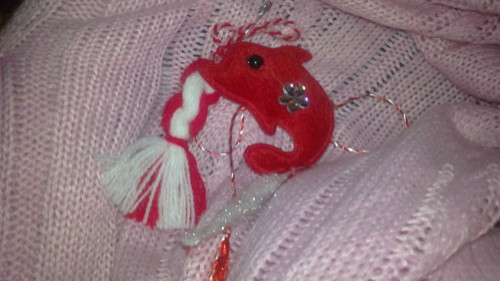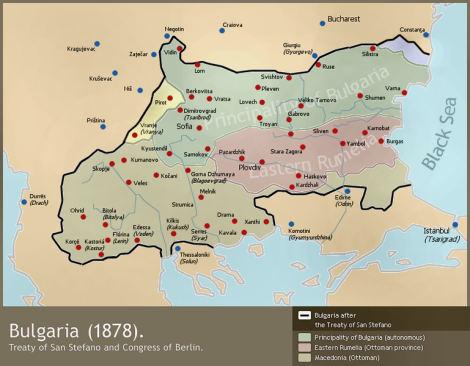1st Of March! 3rd Of March.
Snowy DayMarch 1st.
Martenista (Bulgarian: мартеница, pronounced [ˈmartɛnit͡sa]; plural мартеници martenitsi) is a small piece of adornment, made of white and red yarn and worn from March 1 until around the end of March (or the first time an individual sees a stork, swallow, or budding tree). The name of the holiday is Baba Marta. "Baba" (баба) is the Bulgarian word for "grandmother" and Mart (март) is the Bulgarian word for the month of March. Baba Marta is a Bulgarian tradition related to welcoming the upcoming spring. The month of March, according to Bulgarian folklore, marks the beginning of springtime. Therefore, the first day of March is a traditional holiday associated with sending off winter and welcoming spring.
 I don't have much cause I didn't bought any , but my friends give me anyway!
I don't have much cause I didn't bought any , but my friends give me anyway!
 These I wear on my top or t-shirt!
These I wear on my top or t-shirt!
So March 1st is a really good day!! Unnie just got two ''B''s One when the Bulgarian teacher asked me questions (honestly I didn't read a thing) and in Chemistry! And this is Monica's and mine Super Junior proect!
 On the first day of March and for a few days afterwards, Bulgarians exchange and wear white and red tassels or small dolls called "Пижо и Пенда" (Pizho and Penda). In Bulgarian folklore the name Baba Marta (in Bulgarian баба Марта meaning Grandma March) is related to a grumpy old lady whose mood swings change very rapidly.
On the first day of March and for a few days afterwards, Bulgarians exchange and wear white and red tassels or small dolls called "Пижо и Пенда" (Pizho and Penda). In Bulgarian folklore the name Baba Marta (in Bulgarian баба Марта meaning Grandma March) is related to a grumpy old lady whose mood swings change very rapidly.
This is an old pagan tradition that remains almost unchanged today. The common belief is that by wearing the red and white colours of the martenitsa people ask Baba Marta for mercy. They hope that it will make winter pass faster and bring spring. Many people wear more than one martenitsa. They receive them as presents from relatives, close friends and colleagues. Martenitsa is usually worn pinned on the clothes, near the collar, or tied around the wrist. The tradition calls for wearing the martenitsa until the person sees a stork or a blooming tree. The stork is considered a harbinger of spring and as evidence that Baba Marta is in a good mood and is about to retire.The ritual of finally taking off the martenitsa may be different in different parts of Bulgaria. Some people would tie their martenitsa on a branch of a fruit tree, thus giving the tree health and luck, which the person wearing the martenitsa has enjoyed himself while wearing it. Others would put the martenitsa under a stone with the idea that the kind of creature (usually an insect) closest to the token the next day will determine the person's health for the rest of the year. If the creature is a larva or a worm, the coming year will be healthy, and full of success. The same luck is associated with an ant, the difference being that the person will have to work hard to reach success. If the creature near the token is a spider, then the person is in trouble and may not enjoy luck, health, or personal success.
The martenitsa is also a stylized symbol of Mother Nature. During early-spring/late-winter, nature seems full of hopes and expectations. The white symbolizes the purity of the melting white snow and the red symbolizes the setting of the sun which becomes more and more intense as spring progresses. These two natural resources are the source of life. They are also associated with the male and female beginnings.
Wearing one or more martenitsi is a very popular Bulgarian tradition. The martenitsa symbolises new life, conception, fertility, and spring. The time during which it is worn is meant to be a joyful holiday commemorating health and long life. The colours of the martenitsa are interpreted as symbols of purity and life, as well as the need for harmony in Nature and in people's lives.
Unnie don't have a lot of time..biame!!
March 3rd.
 Bulgaria celebrates Thursday the country’s National Holiday, March 3rd and the 133 rd anniversary of its Liberation from five centuries of Ottoman dominance.
Bulgaria celebrates Thursday the country’s National Holiday, March 3rd and the 133 rd anniversary of its Liberation from five centuries of Ottoman dominance.
Liberation Day is a public holiday in Bulgaria.
Bulgaria celebrates a yearly celebration of its liberation from almost 500 years of Ottoman rule on the 3rd of March under the Treaty of San Stefano. The Treaty of San Stefano ended the Russo-Turkish War in 1877 and paved the way for the liberation of Bulgaria and once again establishes itself as a nation and successfully put the country back on the world map.
History of Bulgaria’s Liberation Day
Bulgaria was already a sovereign nation with established culture, language, arts, technology, among others even before it succumbed to the forces of the Ottoman Empire in 15th century.
Bulgaria’s nationhood was established back in the early 7th century (A.D.) when the first Bulgarian Empire began at around 632 and 681 A.D lasting until 1018 covering most of the Balkans, a geopolitical region in Southern Europe. Bulgarians had their own government, and distinct culture, education, literature, arts, religion and economic way of life before the Turks came in. The Slavic people consider Bulgaria as the centre of European culture and arts before the Ottoman Empire colonized the region.
The Ottoman Empire occupied Bulgaria from the latter half of the 14th century (or 15th century in some literature) until the end of Russo-Turkish War in 1877-1878 taking advantage of the decline in power of the Second Bulgarian Empire between 1185 and 1396/1422. Right after the Russo-Turkish War, Bulgaria saw the opportunity to re-establish its Third Bulgarian Empire and founded a new era of constitutional monarchy in 1878 as supported by the Treaty of San Stefano.

Coat of arms of Republic of Bulgaria
Today, through various legislations, Bulgaria’s government is now under parliamentary democracy within a constitutional republic where the head of the state is run by people who are elected by Bulgarians through popular vote. Bulgaria is a member of several international intergovernmental organizations such as the NATO, European Union, United Nations and the World Trade Organizations, among others.
Although the liberation of Bulgaria from Ottoman dominance was made in 1888, it was not considered as a public holiday until 1978.

 This is how the fight looked like!
This is how the fight looked like!
Liberty Monument at “Shipka”

Bulgaria after the Treaty of San Stefano
If I have to start writing about our history you will end up sleeping!! So with two words the Turks ruled Bulgaria for like 500 years and on that day March 3rd we beat them up!! Kekekeke!

Comments